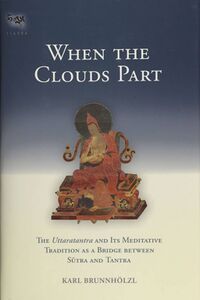Explore: Difference between revisions
No edit summary |
((by SublimeText.Mediawiker)) |
||
| Line 46: | Line 46: | ||
|image=https://commons.tsadra.org/images-commons/thumb/a/a3/Ascetic_Sumedha_and_Dipankara_Buddha.jpg/320px-Ascetic_Sumedha_and_Dipankara_Buddha.jpg | |image=https://commons.tsadra.org/images-commons/thumb/a/a3/Ascetic_Sumedha_and_Dipankara_Buddha.jpg/320px-Ascetic_Sumedha_and_Dipankara_Buddha.jpg | ||
|content=The doctrine of buddha-nature became widespread in India in the first centuries of the Common Era. Although the ideas have roots that stretch back to the earliest teachings of the Buddha, the concept of tathāgatagarbha—"womb or seed of buddhahood"—was first taught in Mahāyāna communities. It was related to, but most likely distinct from both Madhyamaka and Yogācāra, the dominant schools of the Mahāyāna, emerging primarily from a corpus of scripture collectively known as Tathāgatagarbha sūtras and a commentary on them known as the Ratnagotravibhāga. As these scriptures circulated in India and were translated into Chinese and Tibetan, buddha-nature theory spread and was ultimately integrated—albeit with significant differences—into all philosophical schools and traditions of Mahāyāna Buddhism, from Japanese Zen to Tibetan Mahāmudrā. | |content=The doctrine of buddha-nature became widespread in India in the first centuries of the Common Era. Although the ideas have roots that stretch back to the earliest teachings of the Buddha, the concept of tathāgatagarbha—"womb or seed of buddhahood"—was first taught in Mahāyāna communities. It was related to, but most likely distinct from both Madhyamaka and Yogācāra, the dominant schools of the Mahāyāna, emerging primarily from a corpus of scripture collectively known as Tathāgatagarbha sūtras and a commentary on them known as the Ratnagotravibhāga. As these scriptures circulated in India and were translated into Chinese and Tibetan, buddha-nature theory spread and was ultimately integrated—albeit with significant differences—into all philosophical schools and traditions of Mahāyāna Buddhism, from Japanese Zen to Tibetan Mahāmudrā. | ||
|watermark=Subject | |||
}} | |||
{{LocalTile | |||
|classes=col-sm-6 col-lg-4 | |||
|link=Themes | |||
|header=The Themes | |||
|image=https://commons.tsadra.org/thumb.php?f=Jason-leung-D4YrzSwyIEc-unsplash.jpg&width=800 | |||
|content=Here you will find some examples of major themes in which the influence of buddha-nature is readily apparent. | |||
|watermark=Subject | |watermark=Subject | ||
}} | }} | ||
| Line 150: | Line 158: | ||
|image=https://commons.tsadra.org/images-commons/thumb/7/7f/Articles.jpeg/320px-Articles.jpeg | |image=https://commons.tsadra.org/images-commons/thumb/7/7f/Articles.jpeg/320px-Articles.jpeg | ||
|text=The Bibliography | |text=The Bibliography | ||
}} | }} | ||
</div> | </div> | ||
Revision as of 12:54, 23 September 2022

See all presentations
Klaus-Dieter Mathes
Ngawang Jorden
Jacqueline Stone

Panel Description: Continued scholarly publications, Buddhist teaching events, the recent development of online buddha-nature resources, and the associated Tathāgatagarbha symposium in Vienna in 2019 have spurred greater interest in the topic both within Tibetan Buddhist traditions and among other spiritual traditions. This panel brings together experts in an attempt to refine and deepen our understanding of buddha-nature both in terms of theoretical interpretations and practical applications in Tibetan Buddhist communities, past or present.
The main objective of the panel focuses on the interplay between points of doctrine and the practice of the path from the perspective of various Tibetan traditions and scholars. Contributions examine the interpretations of doctrines of tathāgatagarbha originally found in Indian scriptural sources. The methodological approach of these contributions range from historical-philological investigations to ethnographic research and comparative analysis.
See all presentations
Christopher Jones
Casey Forgues
Yaroslav Komarovski
The writer-in-digital-residence is the recipient of a grant designed to support Tsadra Foundation’s Buddhist literacy projects that connect the larger public with academic research and advance understanding of specific aspects of Tibetan Buddhist traditions. Writers help to curate this online resource and write essays on the history, philosophy, and practices associated with buddha-nature teachings and tathāgatagarbha theory in Tibet. These essays are addressed to an audience of educated readers of Buddhist materials and Buddhist practitioners.
Lopen (Dr) Karma Phuntsho is one of Bhutan’s leading intellectuals. He has finished monastic training in Bhutan and India before he pursued a M.St in Classical Indian Religions, and D.Phil in Oriental Studies at Balliol College, Oxford. He was a researcher at CNRS, Paris, a Research Associate at Department of Social Anthropology and the Spalding Fellow for Comparative Religion at Clare Hall, Cambridge University, and Research Consultant at University of Virginia. An author of over hundred books and articles including the authoritative History of Bhutan and Mipham’s Dialectics and the Debates on Emptiness, he speaks and writes extensively on Bhutan and Buddhism. Read a complete bio.
Tsadra Foundation is excited to support Karma Phuntsho in developing a series of online events called "Conversations on Buddha-Nature". This podcast-like project will be space for stimulating and inspiring conversations on Buddha-Nature and related subjects. As a part of the Buddha-Nature Project of the Tsadra Foundation, Karma Phuntsho will host conversations with a Buddhist leader, influencer or expert each month on the theories and practices of Buddha-Nature, which will be live on Facebook. An exercise of mindful listening, right speech, and wholesome exploration of meaning and nature of life, these conversations aim to enhance the understanding and awareness of Buddha-Nature and promote the ethos of innate goodness and positive perception.
Ringu Tulku
Tokpa Tulku
I.28
རྫོགས་སངས་སྐུ་ནི་འཕྲོ་ཕྱིར་དང་། །
དེ་བཞིན་ཉིད་དབྱེར་མེད་ཕྱིར་དང་། །
རིགས་ཡོད་ཕྱིར་ན་ལུས་ཅན་ཀུན། །
རྟག་ཏུ་སངས་རྒྱས་སྙིང་པོ་ཅན། །
Since suchness is undifferentiable,
And because of the disposition,
All beings always possess the buddha heart.
संबुद्धकायस्फरणात् तथताव्यतिभेदतः
गोत्रतश्च सदा सर्वे बुद्धगर्भाः शरीरिणः
佛法身遍滿 真如無差別
皆實有佛性 是故說常有
Click to view all verses





